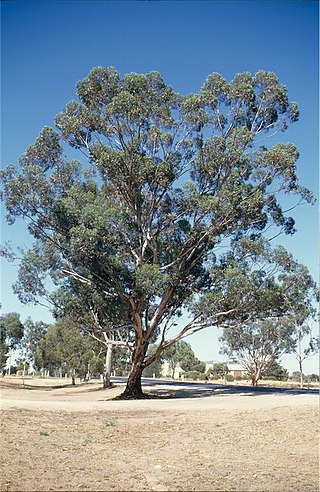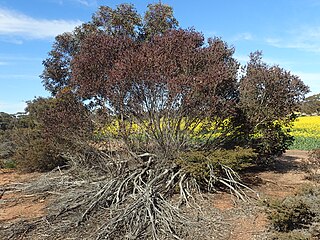Quandong, quandang or quondong is a common name for the species Santalum acuminatum, especially its edible fruit, but may also refer to:

Santalum is a genus of woody flowering plants in the Santalaceae family, the best known and commercially valuable of which is the Indian sandalwood tree, S. album. Members of the genus are trees or shrubs. Most are root parasites which photosynthesize their own food, but tap the roots of other species for water and inorganic nutrients. Several species, most notably S. album, produce highly aromatic wood, used for scents and perfumes and for herbal medicine. About 25 known species range across the Indomalayan, Australasian, and Oceanian realms, from India through Malesia to the Pacific Islands, as far as Hawaiʻi and the Juan Fernández Islands off the coast of South America.

Santalum acuminatum, the desert quandong, is a hemiparasitic plant in the sandalwood family, Santalaceae, which is widely dispersed throughout the central deserts and southern areas of Australia. The species, especially its edible fruit, is also commonly referred to as quandong or native peach. The use of the fruit as an exotic flavouring, one of the best known bush tucker, has led to the attempted domestication of the species.

Acacia acuminata, known as mangart and jam, is a tree in the family Fabaceae. Endemic to Western Australia, it occurs throughout the south west of the State. It is common in the Wheatbelt, and also extends into the semi-arid interior.

Allocasuarina fraseriana, commonly known as western sheoak, or Fraser's sheoak is a species of flowering plant in the family Casuarinaceae, and is endemic to the south-west of Western Australia. The Noongar peoples know the tree as kondil,condil, kulli or gulli. It is a monoecious tree that has branchlets up to 300 mm (12 in) long, the leaves reduced to scales in whorls of six to eight, and the mature fruiting cones 15–40 mm (0.59–1.57 in) long, containing winged seeds (samaras) 9–10 mm (0.35–0.39 in) long.

Santalum spicatum, the Australian sandalwood, also Waang and other names (Noongar) and Dutjahn (Martu), is a tree native to semi-arid areas at the edge of Southwest Australia, in the state of Western Australia. It is also found in South Australia, where it is protected and listed as a vulnerable species. It is traded as sandalwood, and its sandalwood oil has been used as an aromatic and a food source over history. S. spicatum is one of four Santalum species occurring in Australia.

Eucalyptus macrocarpa, commonly known as mottlecah, is a species of mallee that is endemic to the south-west of Western Australia. It has smooth bark, usually sessile, heart-shaped adult leaves arranged in opposite pairs, large red flowers and broad conical fruit.

The western mouse or walyadji is a species of rodent in the family Muridae. Once widespread across a larger range, it has become restricted to around ten reserves of remnant bushland in Southwest Australia and declared near threatened by extinction. They are small and robust mice that live in burrows in sandy soil, venturing out at night to forage in nearby area.

Santalum lanceolatum is an Australian tree of the family Santalaceae. It is commonly known as desert quandong, northern sandalwood, sandalwood, or true sandalwood and in some areas as burdardu. The mature height of this plant is variable, from 1 to 7 m. The flowers are green, white, and cream, appearing between January and October. The species has a distribution throughout central Australia, becoming scattered or unusual in more southern regions.

Spinifex longifolius, commonly known as beach spinifex, is a perennial grass that grows in sandy regions along the seacoast. It also lives in most deserts around Australia.

Xanthorrhoea preissii, known as balga, is a widespread species of perennial monocot in Southwest Australia.

Amyema quandang is a species of hemi-parasitic shrub which is widespread throughout the mainland of Australia, especially arid inland regions, sometimes referred to as the grey mistletoe.

Xylomelum occidentale, commonly known as the western woody pear, is a tree species in the family Proteaceae. It is endemic to Western Australia.

Lambertia orbifolia, commonly known as the roundleaf honeysuckle, is a shrub or small tree that is endemic to the south-west of Western Australia. It has more or less circular leaves and groups of between four and six orange-red flowers.

Eucalyptus angulosa, also known as the ridge fruited mallee or southern ridge fruited mallee, is a eucalypt that is native to Western Australia. The Noongar peoples know the tree as quarral or kwaral.

Eucalyptus astringens, commonly known as brown mallet or to Noongar people as mallat, woonert or wurnert, is a tree that is endemic to the South West region of Western Australia. It has smooth, shiny bark on its trunk and branches, lance-shaped leaves, pendulous flower buds arranged in groups of seven, cream-coloured to pale lemon-coloured flowers and cup-shaped to bell-shaped or conical fruit. This tree has also been introduced to Victoria.

Eucalyptus gardneri, commonly known as blue mallet, or woacal, is a species of mallet with flower buds in groups of between seven and eleven, creamy yellow or pale lemon-coloured flowers and cylindrical to barrel-shaped fruit.
Platysace cirrosa, commonly known as karna, is a perennial herb that is endemic to Western Australia. The Noongar name for the plant is kanna.
Platysace maxwellii, commonly known as native potato or karno, is a shrub that is endemic to Western Australia. The Noongar names for the plant are karno and yook, with the latter name also referring to the closely related species Platysace deflexa which grows further south.
Synaphea polymorpha, commonly known as Albany synaphea, is a species of small shrub in the flowering plant family Proteaceae. It is endemic to Western Australia. The Noongar peoples know the plant as bindak.
















